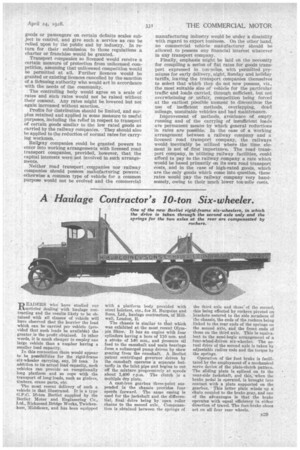A Haulage Contractor's 10-ton Six - wheeler.
Page 55

If you've noticed an error in this article please click here to report it so we can fix it.
One of The new Bei-liet rigid-frame six-wheelers, in which the drive is taken through the second axle only and the springs for the two axles at the rear are compensated by rochers.
READERS who have studied our articles dealing with haulage cantracting and the results likely to be obtained with all classes of vehicle will have observed that the heavier the load which can be carried per vehicle (provided that such loads be available) the greater is the profit obtained. In other words, it is much cheaper to employ one large vehicle than a number having a smaller load capacity.
In this connection there would appear to be possibilities for the rigid-frame six-wheeler carrying, say, 10 tons. In addition to its actual road capacity, such vehicles can provide an exceptionally long platform and so cope with the transport of long loads, such as girders, timbers, crane parts, etc.
The most recent delivery of such a vehicle is that illustrated. It is a type (4.P.C. 10-ton Bernet supplied by the Bernet Motor and Engineering Co., Ltd., Richmond Bridge Works, Twickenham, Middlesex, and has been equipped with a platform body provided with stout bolsters, etc., for H. Burgoine and Sons, Ltd., haulage contractors, of Mill, wall, London, E.
The chassis is similar to that which was exhibited at the most recent Olympia Show. It has an engine with four cylinders having a bore of 110 mm. and a stroke of 140 mm., and pressure oil feed to the camshaft and main bearings from a submerged pump driven by skew gearing from the camshaft. A Bernet Patent centrifugal governor driven by the camshaft operates a separate butterfly in the inlet pipe and begins to cut off the mixture progressively at speeds about 1,400 r.p.m. The clutch is a multiple dry plate.
A cast-iron gearbox three-point suspended in the chassis provides four speeds forward. The •same casing is used for the jackshaft and the differential, final drive being by open roller chains to the second axle., Compensation is obtained between the springs of the third axle and those" of the second, this being effected by rockers pivoted on brackets secured to the side members of the chassis, the ends of the rockers being linked to the rear ends of the springs on the second axle, and the front ends of those on the third axle. This is equivalent to the semi-bogie arrangement of a four-wheel-driven Six-wheeler. The actual drive of the second axle is taken by adjustable radius rods and the torque by the springs.
Operation of the foot brake is facilitated by the employment of a mechanical servo device of the plate-clutch pattern.
The sliding plate is splined on to the • near-side jackshaft, and this, when the brake pedal is operated, is brought into contact with a plate supported on the gearbox. This latter plate winds up a chain coupled to the brake gear, and one of the advantages is that the brake operates with equal efficiency in either direction of travel. The foot-brake shoes act on all four rear wheels.




















































































































